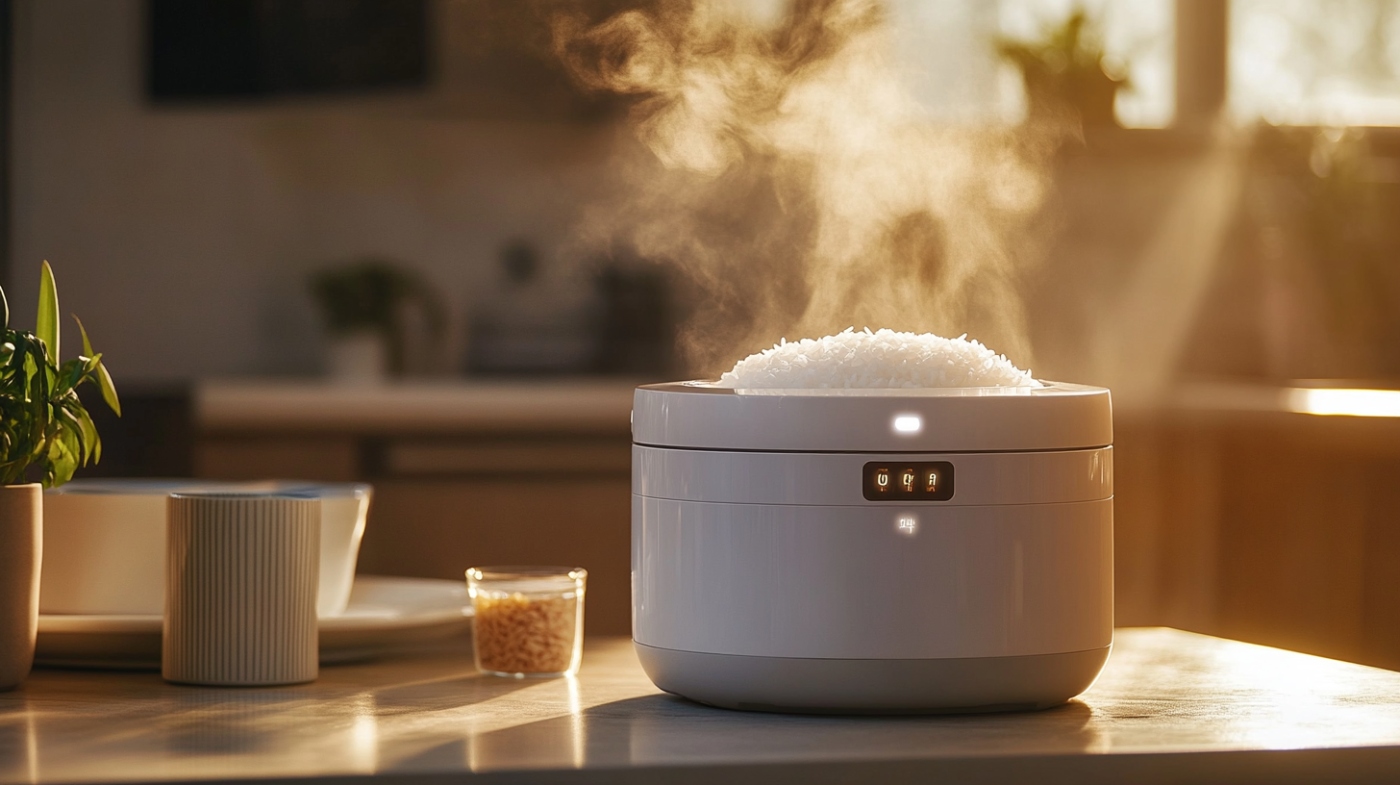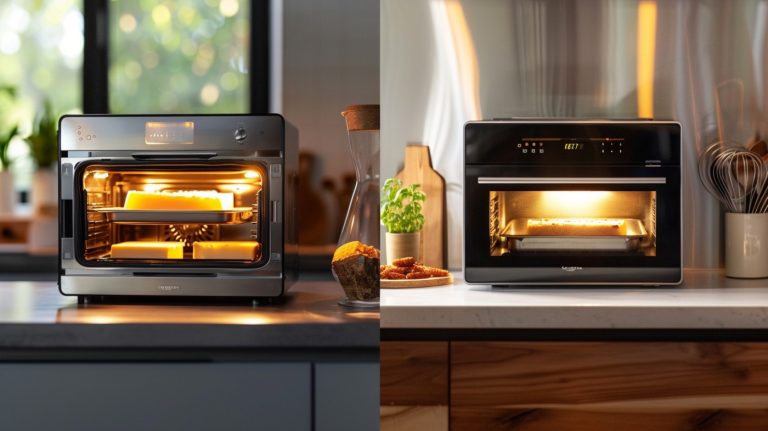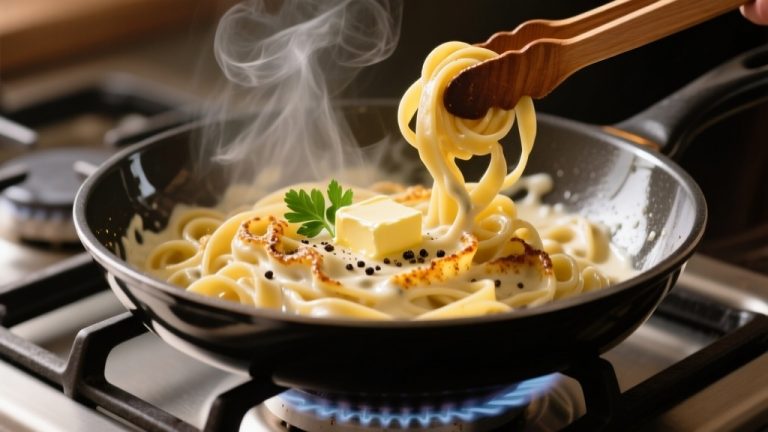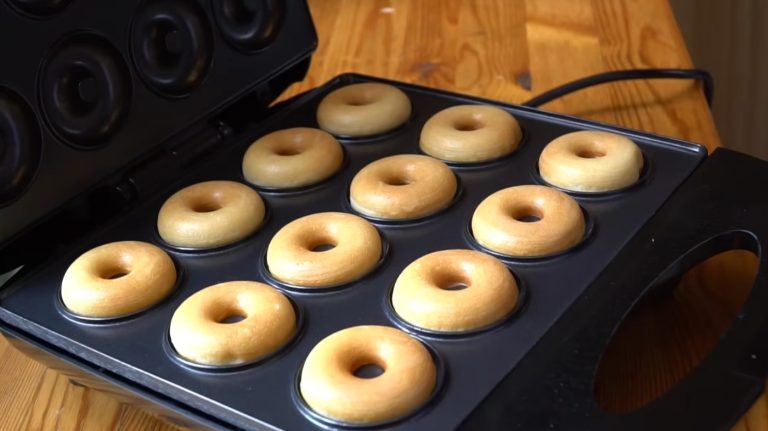How Does a Rice Cooker Know When the Rice Is Done?
A rice cooker knows when the rice is done by employing a precise system of temperature sensors and automatic shut-off mechanisms. It heats water to 212°F (100°C), and as the rice absorbs moisture, the temperature stabilizes. Once the water is fully absorbed, the temperature begins to rise again, triggering the shut-off mechanism.
Additionally, some models use fuzzy logic technology to adapt to different rice types, ensuring ideal cooking. This sophisticated synergy of features minimizes the risk of undercooking or overcooking, guaranteeing perfectly fluffy rice. Exploring further will reveal more about how this nifty appliance operates.
Key Takeaways
- A temperature sensor continuously monitors the cooking pan’s temperature throughout the cooking process.
- The bimetallic switch activates when the temperature exceeds 212°F (100°C), indicating that the rice is done.
- Fuzzy logic technology allows real-time adjustments based on temperature and moisture levels to optimize cooking.
- The rice cooker maintains a stable temperature during water absorption, confirming that the rice is cooking properly.
- An automatic shut-off mechanism triggers when the water is fully absorbed or the temperature exceeds boiling, preventing overcooking.
Components of a Rice Cooker
When you look inside a rice cooker, you’ll find several key components that work together to guarantee perfectly cooked rice. The most vital of these is the temperature sensor, a thermal-sensing device that monitors the cooking pan‘s temperature throughout the process.
As you add rice and water, the sensor detects when the water reaches its boiling point of 212°F (100°C). This indicates that cooking has begun.
In traditional models, a bimetallic switch activates once the temperature exceeds boiling, signaling that the rice is done. However, modern automatic rice cookers have advanced features. They often employ fuzzy logic technology, which allows them to make real-time adjustments based on changes in both temperature and moisture levels.
This guarantees even more accuracy in determining when the rice is perfectly cooked.
The cooking pan itself is another essential component, designed to retain heat while allowing for efficient cooking.
The combination of these components—especially the temperature sensor—guarantees that your rice cooker can automatically adjust cooking times, leading to consistently delicious results without guesswork.
This synergy of technology is what makes automatic rice cookers a staple in many kitchens.
How Cooking Begins
Cooking starts the moment you add rice and water to the inner pan in a 2:1 ratio, which sets the stage for effective heat transfer.
As you place the pan in the cooker, its weight activates a thermal-sensing device that continuously monitors the temperature.
This precise heating mechanism guarantees the water reaches a boil, essential for the rice to cook properly.
Rice and Water Ratio
Achieving the perfect texture in rice starts with the right water-to-rice ratio, typically set at 2:1. This means you need two cups of water for every cup of rice. This balance guarantees proper absorption, resulting in fluffy rice. However, different rice varieties require adjustments. For instance, brown rice typically needs about 30% more water and takes longer to cook.
Here’s a quick reference table for various types of rice:
| Rice Type | Water Ratio | Cooking Time |
|---|---|---|
| White Rice | 2:1 | 10-15 minutes |
| Brown Rice | 2.5:1 | 30-45 minutes |
| Jasmine Rice | 1.75:1 | 10-15 minutes |
| Basmati Rice | 1.5:1 | 15-20 minutes |
| Sushi Rice | 1.2:1 | 20-25 minutes |
Using the provided BPA-free measuring cup guarantees you measure accurately, leading to consistent and ideal cooking results. Remember, the rice cooker automatically detects the presence of water, and as it gets absorbed, the cooking process moves toward completion.
Heating Mechanism Activation
After setting the right water-to-rice ratio and placing the ingredients in the inner cooking pan, the cooking process activates once the pan is positioned on the electric heating plate of the rice cooker.
At this point, a thermal-sensing device engages due to the weight of the pan, allowing the rice cooker to monitor temperature changes throughout the cooking process.
The electric heating plate generates heat, bringing the water to a boil at 212°F (100°C). This temperature stabilizes as long as water remains in the pan.
As the rice absorbs the water, the levels decrease, leading to a gradual rise in temperature within the cooking bowl. Once the water is fully absorbed, the temperature will exceed 100°C, triggering a significant increase.
This sudden temperature spike activates the automatic shut-off mechanism, signaling that the rice is done cooking.
Consequently, the rice cooker shifts into a warming cycle, maintaining the ideal serving temperature without overcooking.
Temperature Monitoring System
In a rice cooker, the temperature monitoring system plays an important role in determining when the cooking process begins and ends. This system utilizes a thermal-sensing device that continuously monitors the temperature of the inner cooking pan.
During the boiling process, when water is present, the temperature stabilizes at 212°F (100°C). As the rice absorbs the water or it evaporates, the temperature starts to rise.
This rise in temperature is essential; once it exceeds the boiling point, the automatic shut-off mechanism activates. This indicates that the rice is done cooking, eliminating the need for manual checking.
The efficiency of the temperature monitoring system allows for accurate detection of doneness, ensuring perfectly cooked rice every time.
Some advanced rice cookers even incorporate fuzzy logic technology, which enables real-time adjustments based on moisture and temperature changes. This enhancement further improves cooking precision, adapting to various rice types and cooking conditions.
The Role of Heat Transfer
When you use a rice cooker, heat transfer plays a crucial role in cooking your rice perfectly.
The choice of materials, like aluminum or non-stick coatings, enhances heat conductivity, ensuring that the temperature remains consistent throughout the cooking process.
As the water reaches its boiling point, the thermal-sensing mechanism kicks in, helping the cooker regulate heat until the rice is ready.
Heat Conductivity Materials
Utilizing materials with high heat conductivity, like aluminum and copper, greatly enhances a rice cooker’s performance by promoting efficient heat transfer.
These heat conductivity materials are essential as they directly affect cooking time. For instance, aluminum, a superior conductor, allows for quicker heat absorption and distribution compared to less efficient materials, ensuring that the rice cooks evenly.
Effective heat transfer is important for maintaining the boiling point of water at 212°F (100°C). When water reaches this temperature, it’s essential for cooking rice properly without burning.
The design of the heating plate combined with the selection of heat conductivity materials determines how quickly the cooker can bring water to a boil, impacting overall cooking performance.
Moreover, a rice cooker’s ability to switch from cooking to warming mode hinges on the efficiency of the inner pot’s materials. As water is absorbed by the rice, temperature changes occur, which the thermal-sensing device detects.
Thermal-Sensing Mechanism
The thermal-sensing mechanism plays an important role in a rice cooker‘s ability to deliver perfectly cooked rice. This system relies on a thermal-sensing device that continuously monitors the temperature of the inner cooking pan throughout the cooking process.
Initially, when you turn on the cooker, the water in the pan heats up, reaching its boiling point of 212°F (100°C). At this stage, the temperature stabilizes, indicating that the cooking process has begun, and the rice starts to absorb water.
As the rice absorbs moisture, the temperature remains constant until all the water is either absorbed or evaporated. Once the water is gone, you’ll notice a sudden rise in temperature. This increase is essential; it triggers the automatic shut-off mechanism. This feature guarantees that your rice doesn’t burn, indicating that it’s fully cooked.
Furthermore, the efficient heat transfer from the heating plate to the cooking pan is significant. It assures even cooking and allows the thermal-sensing device to accurately detect the absence of water, making sure you get consistently perfect rice every time you use your cooker.
Boiling Point Regulation
Understanding how boiling point regulation works is key to mastering rice cooking in a rice cooker. The cooker heats water to its boiling point of 212°F (100°C), which is essential for cooking rice effectively. The thermal-sensing device actively monitors the cooking pan’s temperature, guaranteeing it remains at the boiling point as long as there’s water present.
As the rice absorbs the water, the temperature stays stable; this indicates that the cooking process is ongoing. However, once all the water is absorbed or evaporated, the temperature begins to rise above 100°C. This sudden increase signals the cooker to switch off or shift to a warming mode, indicating your rice is perfectly cooked.
Efficient heat transfer from the heating plate to the cooking pan plays a significant role in this process. It guarantees even cooking throughout the rice, preventing any burning or uneven texture.
Understanding Temperature Regulation
In a rice cooker, precise temperature regulation is essential for achieving perfectly cooked rice. The device employs a thermostat to monitor the internal temperature of the cooking bowl, maintaining it at 212°F (100°C) during the boiling process.
Once all the water is absorbed or evaporated, the temperature begins to rise above this threshold, signaling that cooking is complete.
Key aspects of temperature regulation in a rice cooker include:
- Continuous Monitoring: The cooker constantly checks the temperature, ensuring ideal cooking conditions without your intervention.
- Bimetallic Switch: In simpler models, this switch activates when the temperature exceeds 100°C, prompting a shift from cooking mode to warm mode.
- Automatic Shut-Off: This feature prevents overcooking or burning, allowing you to enjoy rice cooked to the perfect texture.
Mechanisms for Detecting Doneness
Rice cookers employ specific mechanisms for detecting doneness, guaranteeing that your rice is cooked just right. At the heart of these mechanisms is a bimetallic switch that activates when the temperature in the cooker rises just above 100°C (212°F). This temperature change indicates that all the water has been absorbed, signaling that the rice is fully cooked.
As the rice absorbs water, the temperature remains stable at the boiling point. Once the water is gone, the temperature suddenly rises, triggering the switch and confirming doneness. The combination of a heating element and a thermostat continuously monitors the cooking bowl’s temperature, regulating heat to achieve ideal cooking conditions.
Basic rice cookers utilize simple mechanical switches for this purpose, while more advanced models may incorporate fuzzy logic technology for real-time adjustments, enhancing cooking accuracy.
You might also notice a familiar clunk sound when the switch activates, providing an audible cue that your rice is ready. This precise detection mechanism guarantees that you get perfectly cooked rice every time, eliminating the guesswork involved in traditional cooking methods.
Fuzzy Logic in Rice Cookers
Many home cooks may not realize how fuzzy logic technology transforms the rice cooking experience.
Fuzzy logic cookers utilize advanced algorithms that allow them to make real-time adjustments based on moisture and heat changes during cooking. This capability enhances the precision of cooking, ensuring that your rice is perfectly cooked every time.
- Fuzzy logic systems monitor temperature fluctuations and moisture levels throughout the process.
- These cookers can adapt their cooking methods to suit different rice types, such as brown rice or porridge.
- The use of multiple sensors considerably reduces the chances of undercooked or overcooked rice.
Cooking Times for Various Rice
Understanding the cooking times for various rice types can greatly enhance your culinary results. For instance, white rice usually takes about 20 to 30 minutes to cook in a rice cooker, while brown rice typically takes a longer cooking time, between 30 to 40 minutes. This difference stems from brown rice’s higher fiber content and denser structure.
If you’re looking for quicker options, jasmine and basmati rice cook in roughly 15 to 25 minutes.
It’s essential to note that cooking times can vary greatly based on the specific model of your rice cooker. Many digital models come equipped with preset functions for different rice types, which can streamline the cooking process.
Additionally, for every 2 cups of uncooked rice, the volume generally doubles, yielding about 4 cups of cooked rice. This increase in quantity can also impact cooking times.
Adjusting for Different Altitudes
When you’re cooking rice at higher altitudes, the boiling point of water drops, which can impact how your rice turns out.
You’ll need to adjust both the cooking time and the amount of water you use to achieve ideal results.
Understanding these variations can make a significant difference in your rice cooker’s performance and the texture of your rice.
Boiling Point Variations
As you ascend to higher altitudes, the boiling point of water decreases, which greatly impacts how your rice cooker performs.
At elevations between 3,000 to 5,000 feet, you may only need minor adjustments in water ratios. However, at altitudes of 8,000 to 10,000 feet, significant changes are necessary to avoid undercooked rice.
As water evaporates faster at higher altitudes, you’ll likely find that rice requires more water to achieve the same texture and doneness as at sea level.
To navigate these challenges effectively, consider the following:
- Understand local altitude effects: Knowing your elevation helps you make informed adjustments.
- Experiment with different rice types: Each variety may respond differently to altitude changes, affecting cooking outcomes.
- Adjust cooking times: Lower boiling points mean you may need to increase cooking times for ideal results.
Water Adjustments Needed
At higher altitudes, you need to make specific water adjustments for your rice cooker to guarantee perfectly cooked rice. As you ascend, the boiling point of water decreases, which greatly impacts your cooking process.
For elevations between 3,000 to 5,000 feet, minor adjustments in water should suffice. However, at altitudes of 8,000 to 10,000 feet, you’ll likely require substantial changes to both water amounts and cooking times.
Evaporation rates increase with altitude, so incorporating slightly more water can compensate for the loss during cooking. For instance, if you’re cooking brown rice, remember it requires about 30% more cooking time and water than white rice, further influenced by your specific altitude adjustments.
Familiarizing yourself with local altitude effects on boiling points can enhance your rice cooking success and consistency.
Keep in mind that using too little water can lead to undercooked rice, while too much can result in soggy grains.
Frequently Asked Questions
How Does a Rice Cooker Know When the Water Is Gone?
You might think cooking rice requires constant attention, but a rice cooker uses a thermal sensor. It detects temperature changes when water evaporates, signaling that the cooking process is complete and the rice is ready.
How Does an Automatic Rice Cooker Work?
An automatic rice cooker uses a thermal sensor to monitor temperature changes while cooking. As water boils and evaporates, the cooker adjusts heat automatically, ensuring consistent results and switching off when all water’s absorbed.
Does a Rice Cooker Stop Cooking When the Rice Is Done?
You’ll be amazed! A rice cooker doesn’t just stop cooking—it magically senses when your rice is perfectly done. Once that water’s gone, it switches off, ensuring your meal’s ready for serving without any fuss.
What Is the Science Behind the Rice Cooker?
A rice cooker utilizes thermal sensors to monitor heat, guaranteeing even cooking by detecting water absorption. Advanced models adjust for moisture variations, enhancing accuracy, while the cooking bowl’s material guarantees effective heat transfer for perfect rice every time.
Your Personal Chef: The Science Behind Perfectly Cooked Rice
At its core, a rice cooker acts as a diligent chef, mastering the art of temperature regulation to guarantee perfectly cooked rice. By detecting subtle changes in heat and moisture, it knows when to shift from cooking to warming, like a conductor guiding an orchestra to a harmonious finish.
With its ability to adapt to different rice types and altitudes, this kitchen appliance is a reliable ally, transforming simple grains into fluffy perfection, meal after meal.







